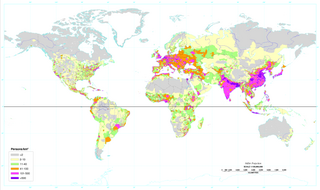

| Rank | Country | Population | Area (km2) | Density |
|---|---|---|---|---|
| — | Bermuda | 65,365 | 53.3 | 1,226 |
| 8 | Barbados | 279,254 | 431 | 647 |
| — | Puerto Rico | 3,916,632 | 9,104 | 430 |
| — | Martinique | 432,900 | 1,100 | 393 |
| — | Aruba | 71,566 | 193 | 370 |
| 23 | El Salvador | 6,704,932 | 21,040 | 318 |
| — | Virgin Islands | 108,708 | 352 | 308 |
| 26 | Saint Vincent and the Grenadines | 117,534 | 389 | 302 |
| 28 | Haiti | 8,121,622 | 27,750 | 292 |
| 29 | Saint Lucia | 166,312 | 616 | 269 |
| — | Guadeloupe | 448,713 | 1,780 | 252 |
| 32 | Jamaica | 2,731,832 | 10,991 | 248 |
| — | Netherlands Antilles | 219,958 | 960 | 229 |
| 36 | Trinidad and Tobago | 1,088,644 | 5,128 | 212 |
| 43 | Dominican Republic | 8,950,034 | 48,730 | 183 |
| — | Cayman Islands | 44,270 | 262 | 168 |
| 47 | Antigua and Barbuda | 68,722 | 443 | 155 |
| 51 | Saint Kitts and Nevis | 38,958 | 261 | 149 |
| — | British Virgin Islands | 22,643 | 153 | 147 |
| 55 | Guatemala | 14,655,189 | 108,890 | 134 |
| — | Anguilla | 13,254 | 102 | 129 |
| 73 | Cuba | 11,346,670 | 110,860 | 102 |
| 80 | Dominica | 69,029 | 754 | 91 |
| — | Montserrat | 9,341 | 102 | 91 |
| 91 | Costa Rica | 4,016,173 | 51,100 | 78 |
| 107 | Honduras | 6,975,204 | 112,090 | 62 |
| 117 | Mexico | 106,202,903 | 1,972,550 | 53 |
| — | Turks and Caicos Islands | 20,556 | 430 | 47 |
| 127 | Nicaragua | 5,465,100 | 129,494 | 42 |
| 132 | Panama | 3,039,150 | 78,200 | 38 |
| 143 | United States | 298,212,900 | 9,629,091 | 31 |
| — | Saint-Pierre and Miquelon | 7,012 | 242 | 28 |
| 152 | The Bahamas | 301,790 | 13,940 | 21 |
| 171 | Belize | 279,457 | 22,966 | 12 |
| 185 | Canada | 32,805,041 | 9,984,670 | 3 |
| — | Greenland | 56,375 | 2,166,086 | 0.03 |
| — | Navassa Island | 0 | 5.2 | 0 |
Sources: Wikipedia (List of countries and dependencies by population density)



